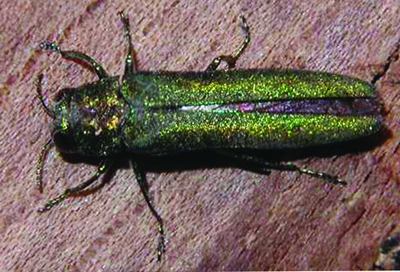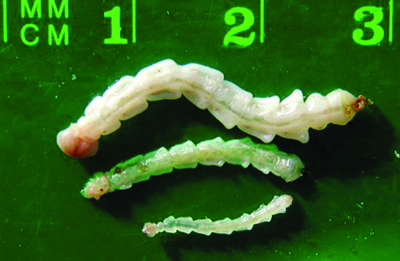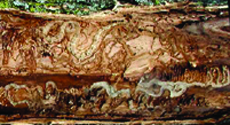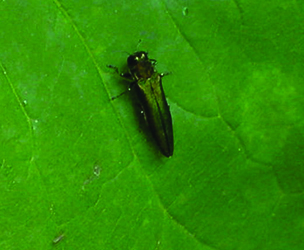Emerald ash borer
July 30, 2015
Agrilus planipennis
All ash species (Fraxinus) grown in Michigan are hosts for emerald ash borer (EAB). Mountain ash (Sorbus) is not a host.

The EAB adult is dark metallic green from about 7.5-13.5 mm long. Females are larger than males.
In Michigan most EAB larvae complete development in one year, but some may take 2 or in some cases even 3 years. Development seems faster on weakened trees and slower on healthy trees with few previous attacks. Adult emergence in southern Michigan begins in mid-May to early June (depending on spring temperatures) and peaks from late June to early July. Adults feed on the edges of ash leaves and remain active through July and early August. Females lay eggs on the bark of trunks or branches. Eggs hatch in 7 to 10 days. Larvae tunnel into the cambium, where they create S-shaped feeding galleries, packed with fine frass.

Fourth instar larvae are 26 to 32 mm long, cream-colored and are flattened like a long, narrow piece of cardboard.
Larvae are creamy white in color and are found under the bark. Larvae pupate in late April to early May. Adult beetles create a D-shaped exit hole when they emerge from the trunk a few weeks later.
Symptoms
Look for D-shaped exit holes (about 3-4 mm in diameter) on branches and the trunk. The canopy of an infested tree thins out and branches die from being girdled by larvae feeding under the bark. Watersprouts form on the trunk at the juncture of live and dead tissue. Infested trees usually die after several years of heavy tunneling.
Management
This pest is under quarantine in Michigan. Efforts are being made to limit its spread, and track locations where it is found. Send any suspect samples from outside the known area of infestation to MSU Diagnostic Services for positive identification by an expert. Drought stress may make trees more vulnerable to attack by EAB, but healthy trees are also attacked. Imidacloprid applied as a basal soil drench, basal soil injection or trunk injection has given good protection of ash trees if treatments begin when trees are still healthy.

Bark removed to show S-shaped galleries caused by larval feeding.
Starting early is important, because imidacloprid soil drenches or basal injections do not provide adequate protection the first year. Saving trees with insecticide treatments is not guaranteed if treatments begin after trees are seriously compromised. Other insecticide treatments are being developed and tested. Consult your local extension educator for current recommendations. For more information visit: www.emeraldashborer.info

Print a PDF of this page: Emerald Ash borer



 Print
Print Email
Email

